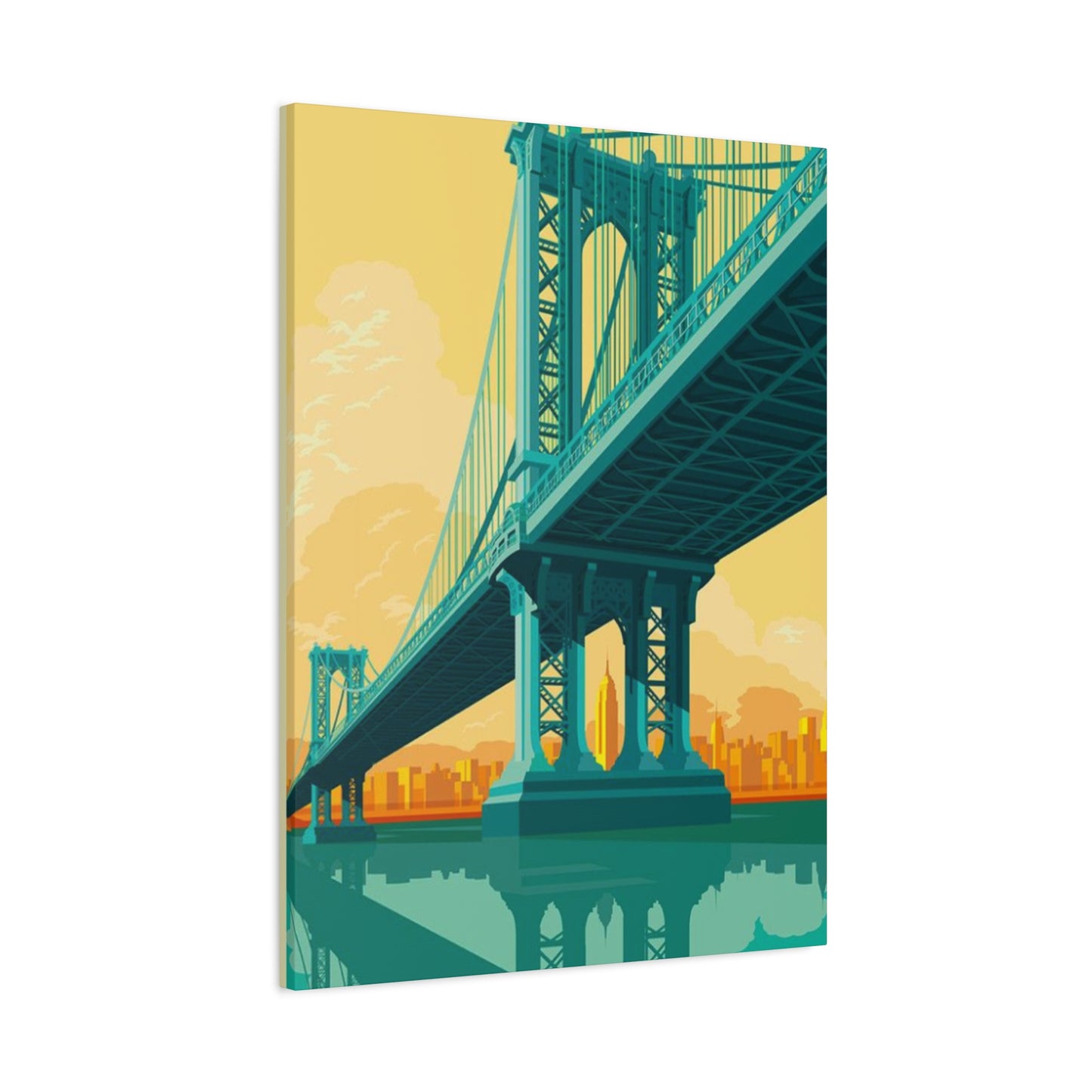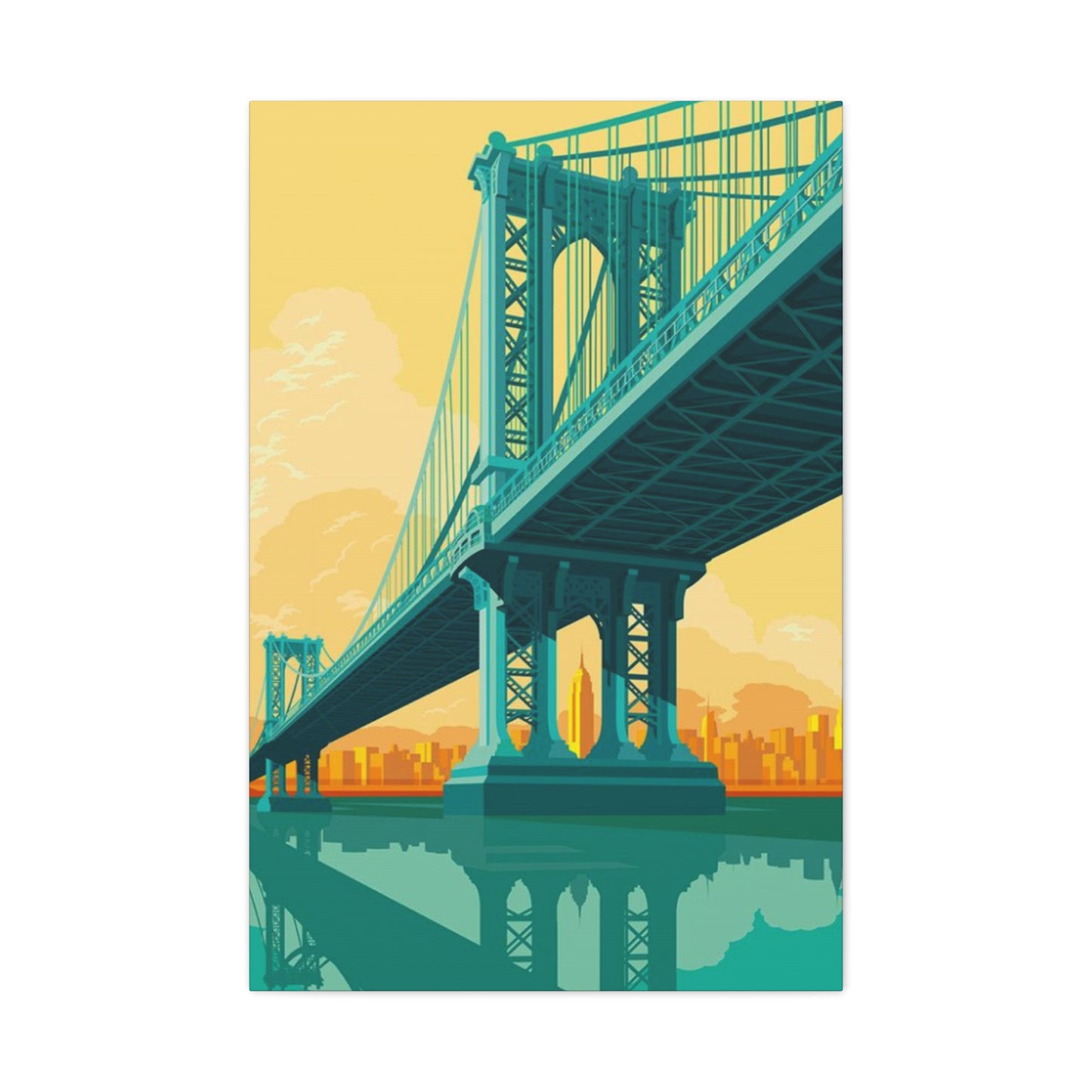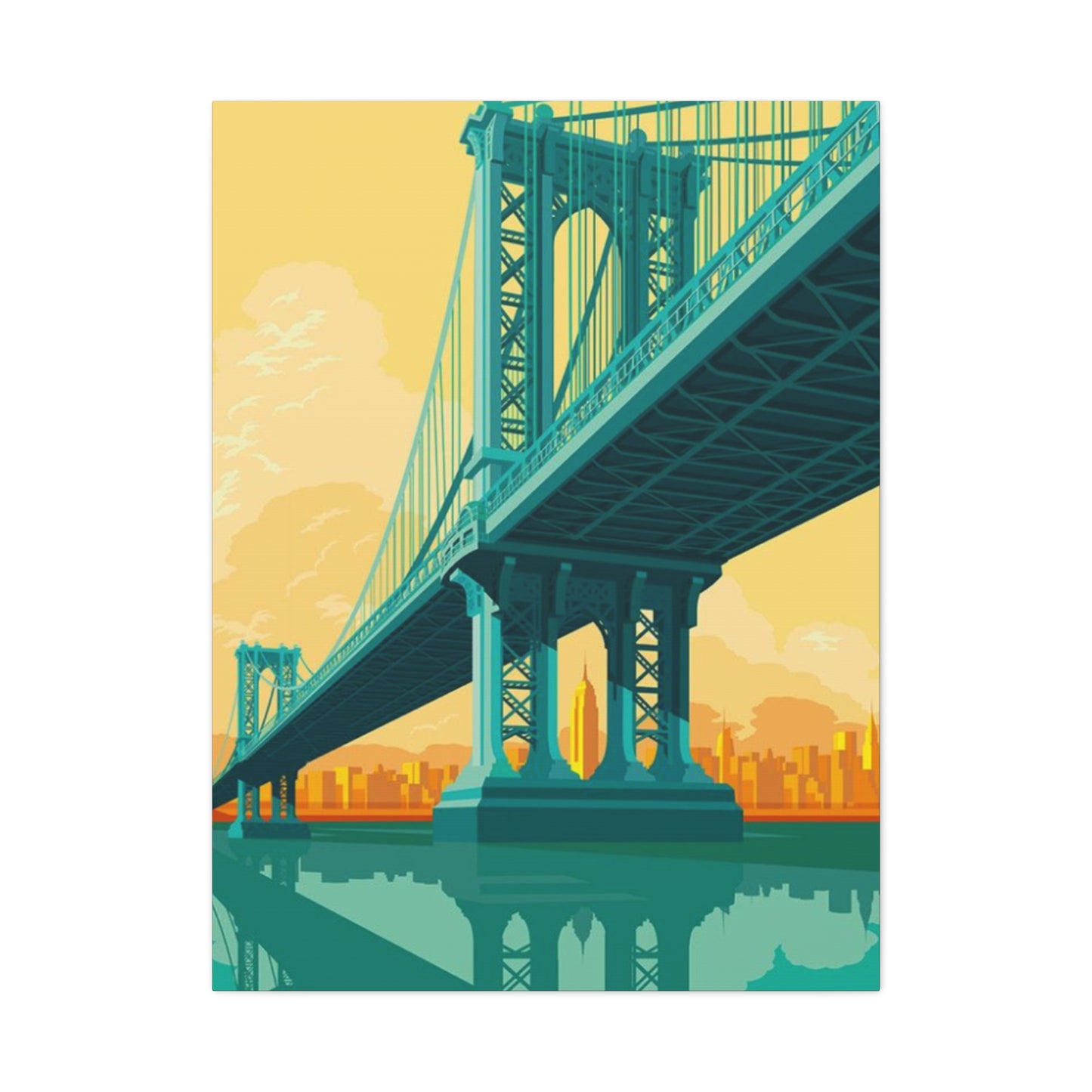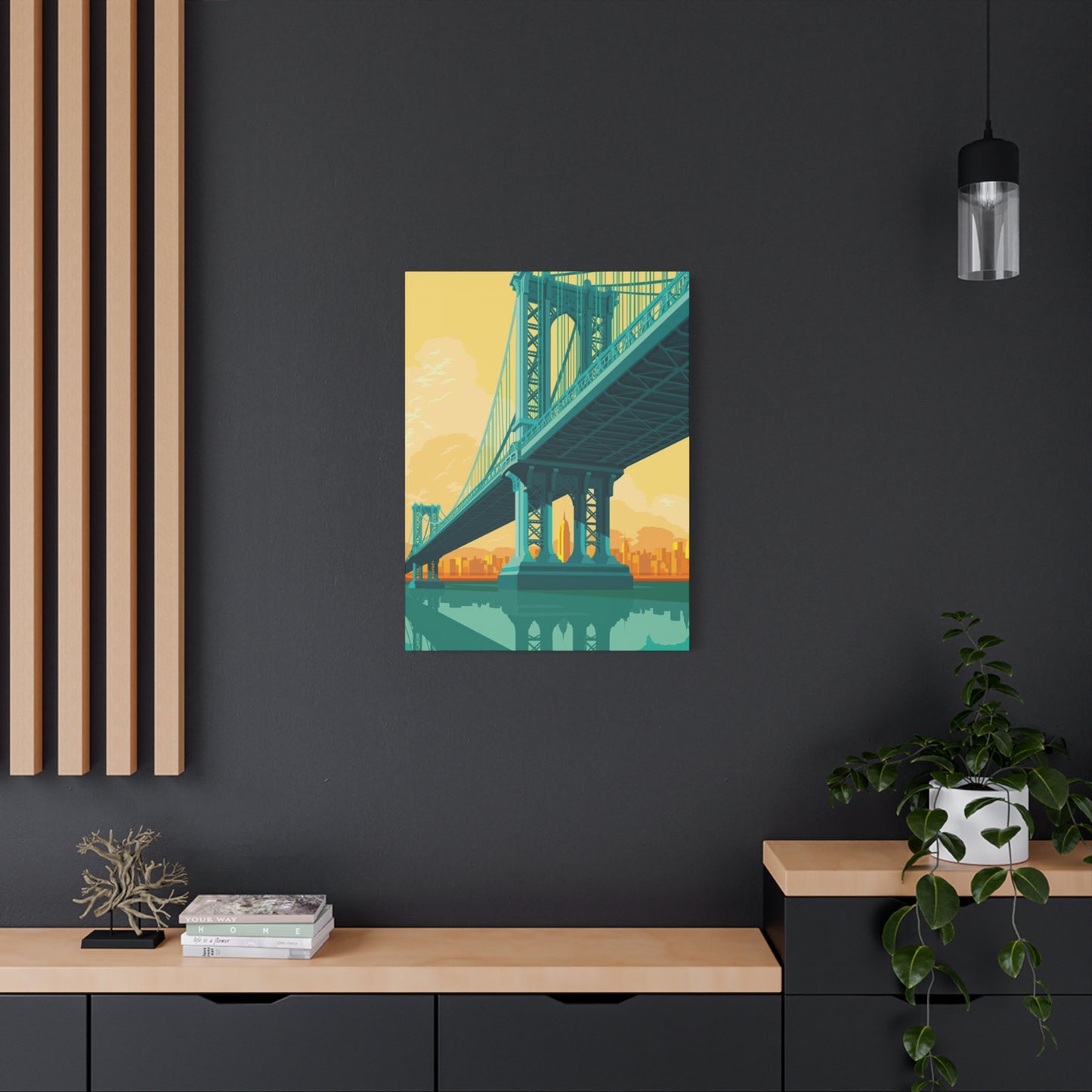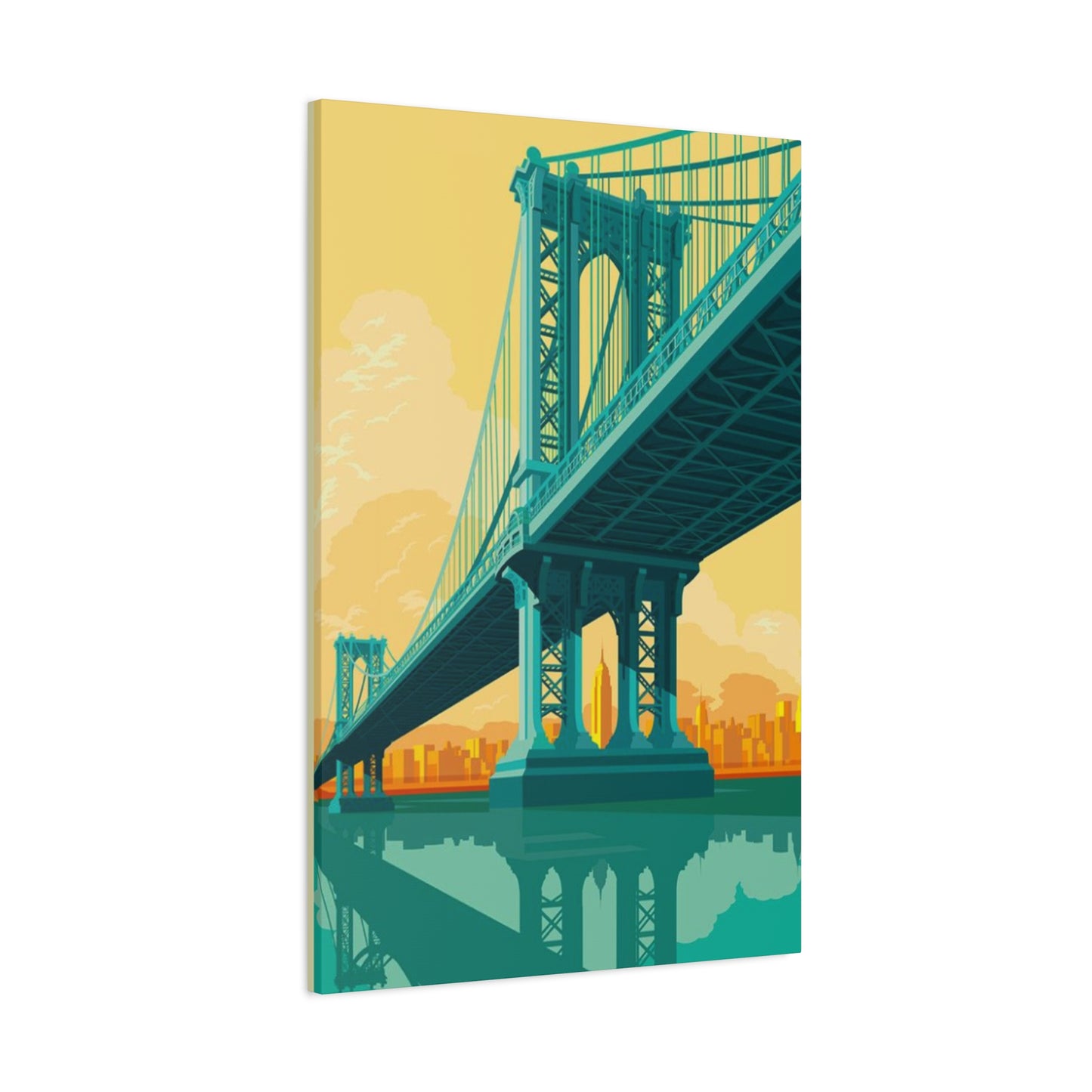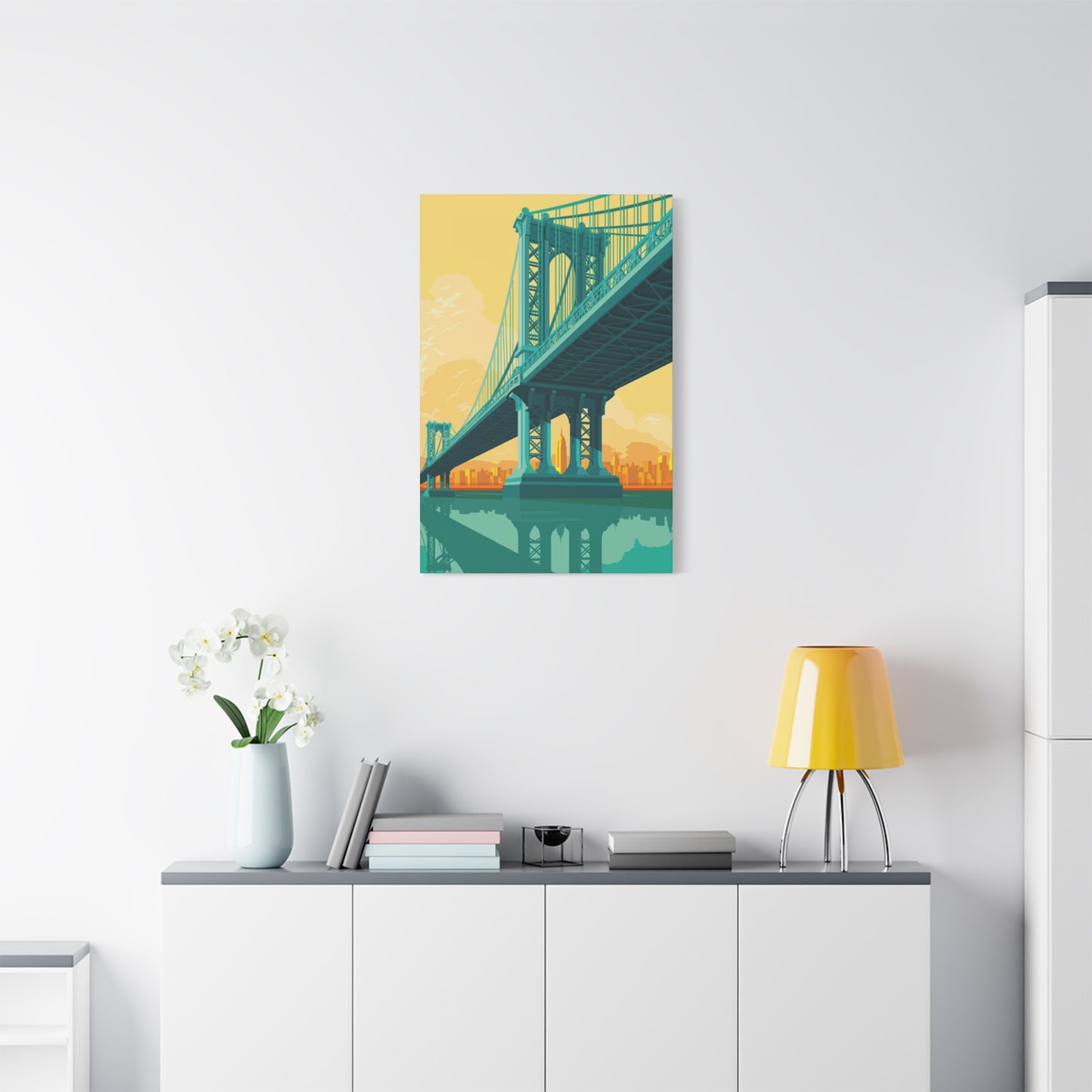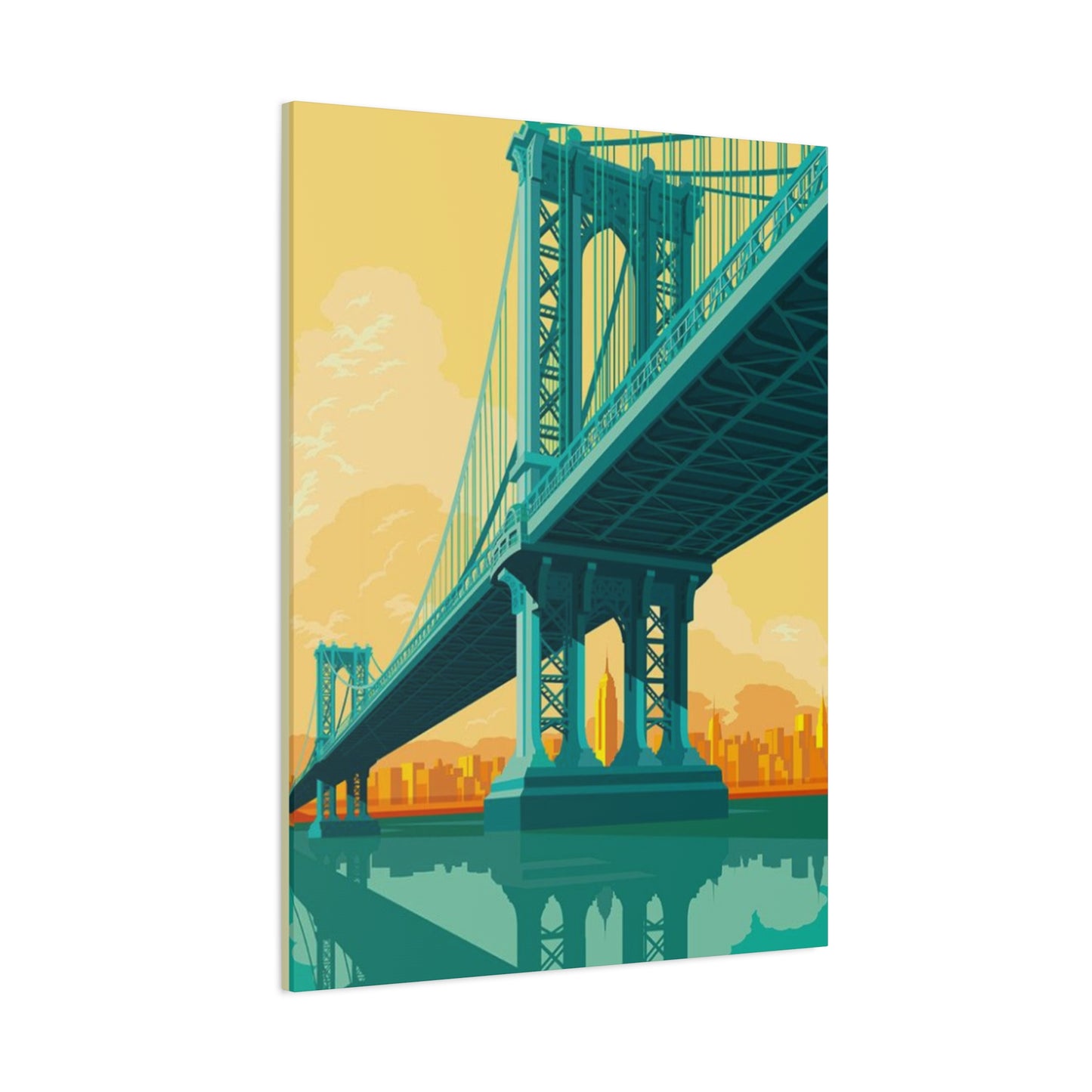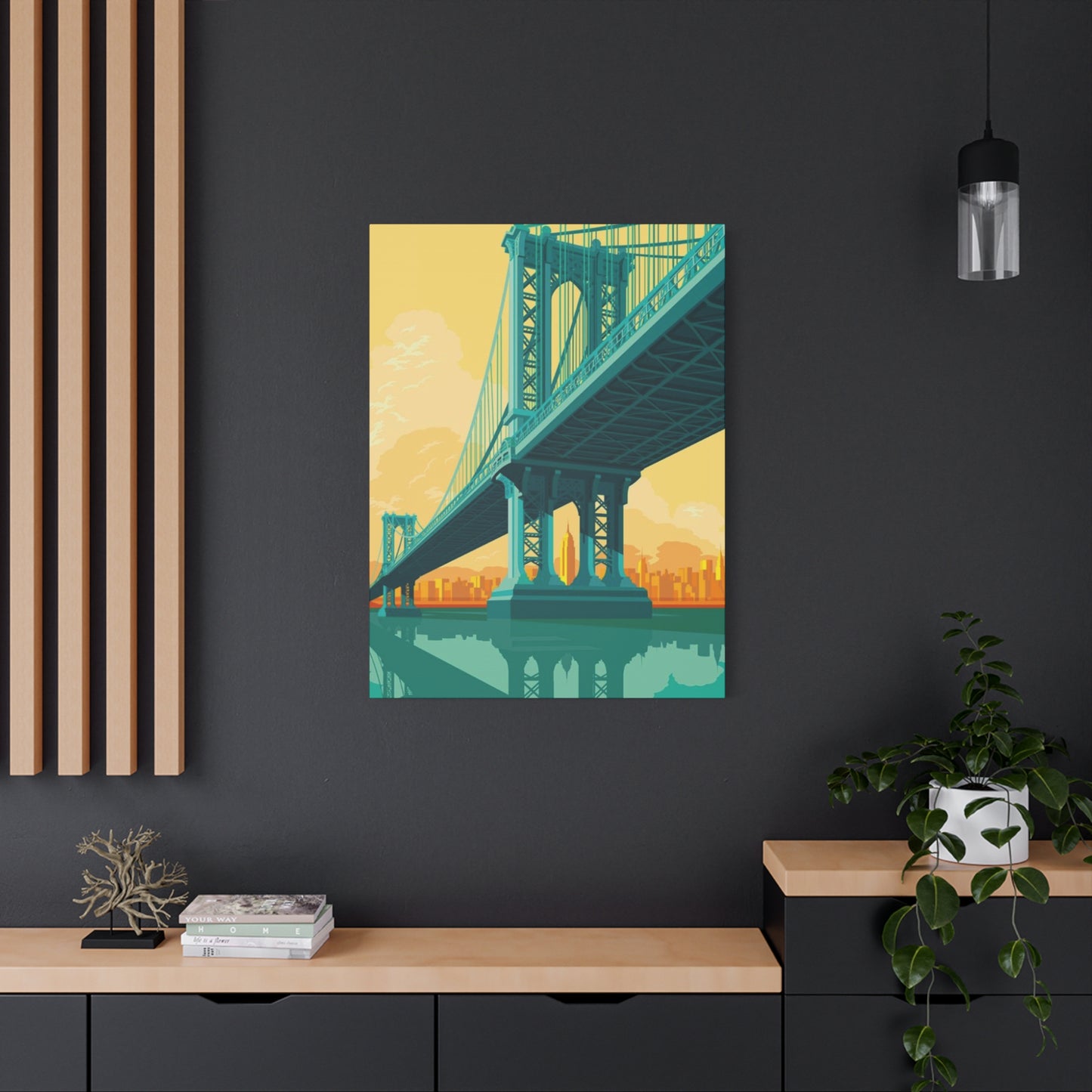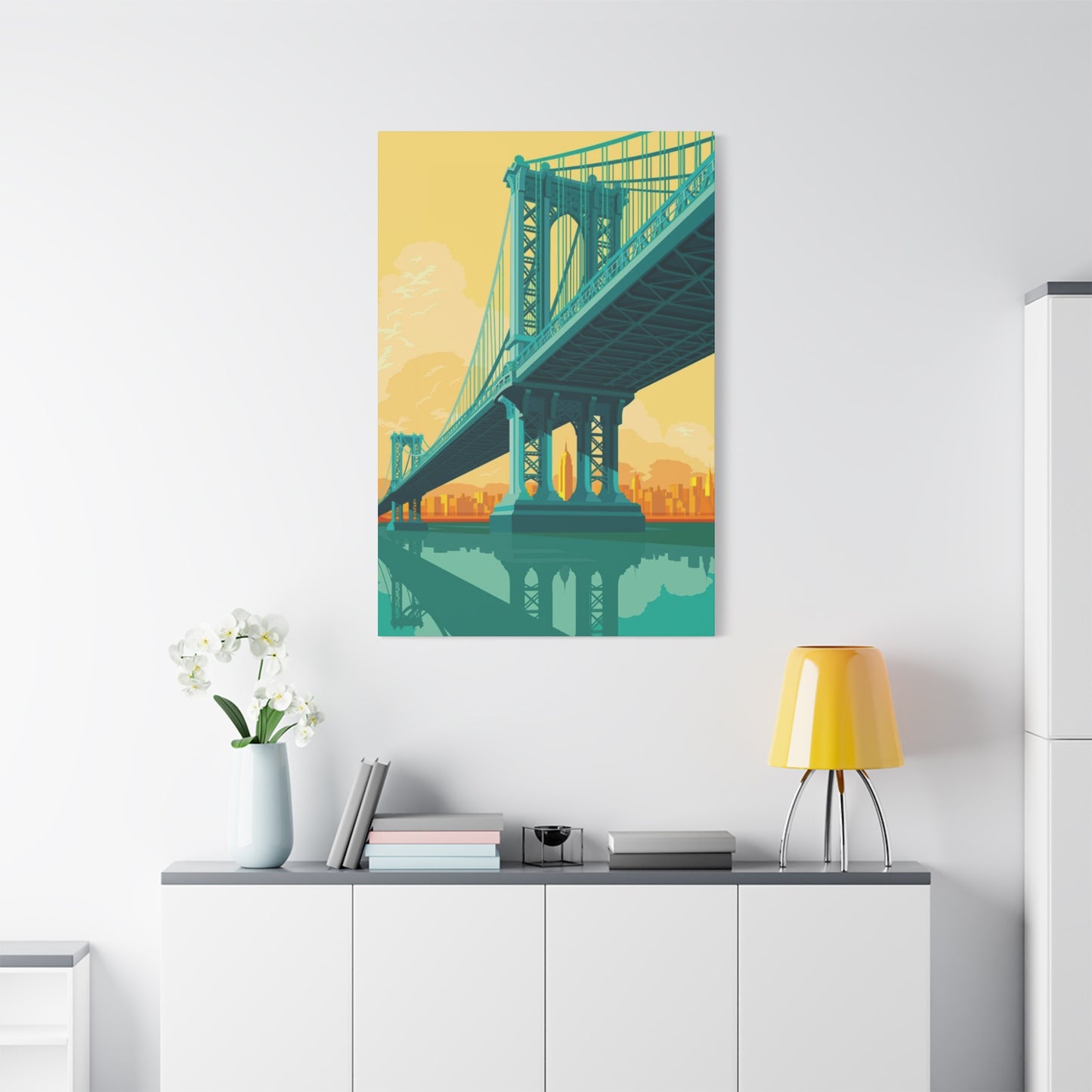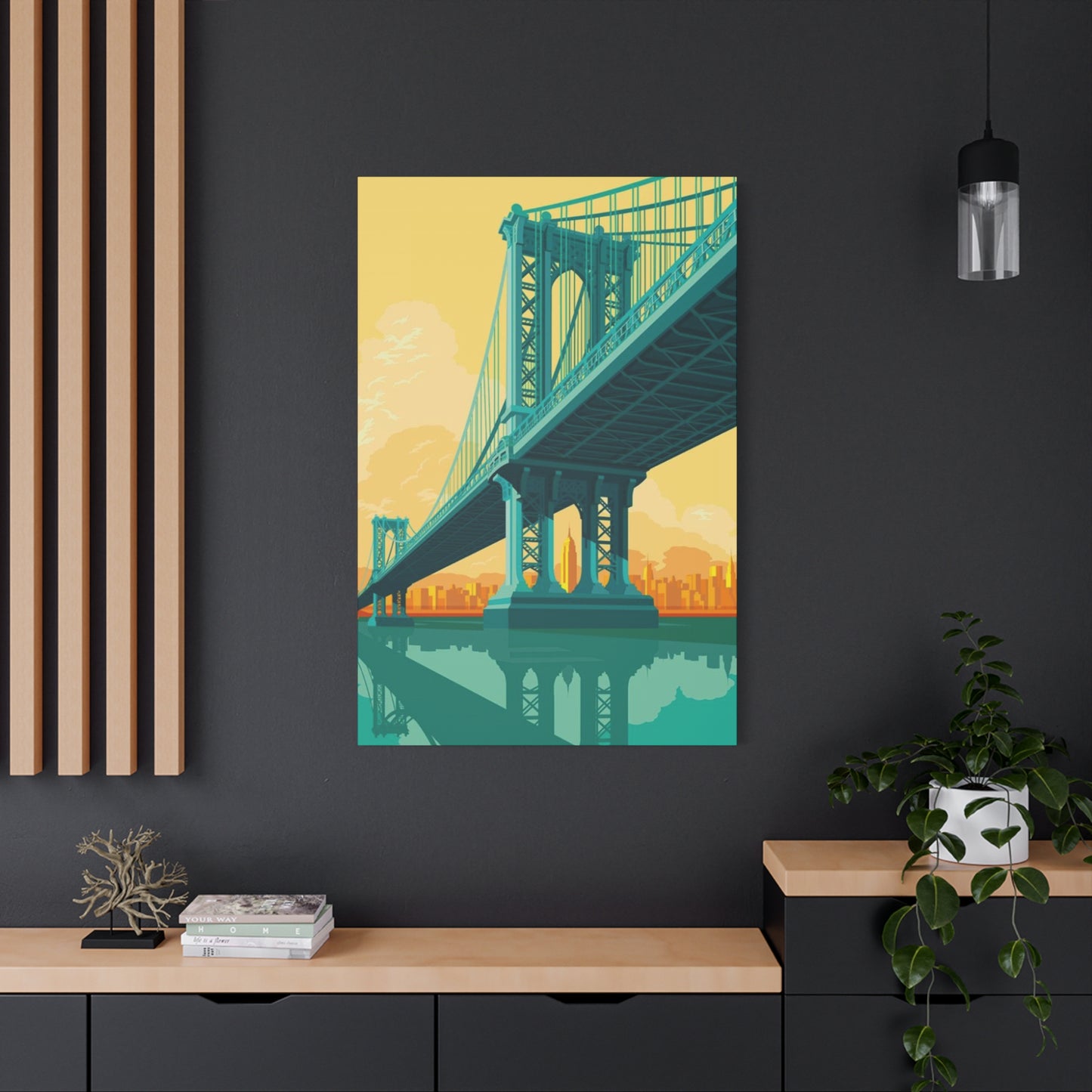New York City Wall Art Featuring the Manhattan Bridge: A Blend of Urban Grace and Modern Style
The Manhattan Bridge stands as one of the most photographed and artistically represented structures in New York City, second only to its more famous neighbor, the Brooklyn Bridge. This suspension bridge, which connects Lower Manhattan to Brooklyn, has become an enduring symbol of urban beauty and architectural excellence. When translated into wall art, the Manhattan Bridge offers homeowners, interior designers, and art enthusiasts a piece of New York's soul that can enliven any living space with metropolitan sophistication.
Wall art featuring the Manhattan Bridge captures more than just a bridge; it encapsulates the essence of New York City itself. The structure's massive steel framework, elegant suspension cables, and distinctive towers create visual interest that works beautifully in various artistic mediums. Whether rendered in black and white photography, vibrant color prints, abstract interpretations, or vintage-style illustrations, this iconic bridge provides endless creative possibilities for wall décor.
The appeal of Manhattan Bridge wall art extends beyond New York residents and tourists. People worldwide recognize this landmark as representing ambition, connection, and the dynamic energy of urban life. Displaying such artwork in your home or office creates an instant conversation piece while adding depth and character to your interior design scheme. The bridge's strong horizontal lines and geometric patterns complement both modern minimalist spaces and more traditional décor styles, making it remarkably versatile.
Historical Significance That Adds Depth to Your Art Collection
Completed in 1909, the Manhattan Bridge represents an important chapter in New York City's development and engineering history. Understanding the bridge's background adds meaningful context to wall art featuring this structure, transforming a simple decoration into a piece with historical resonance. The bridge was designed by Leon Moisseiff, a Polish-born engineer who pioneered the deflection theory used in suspension bridge construction, which later influenced bridges worldwide.
The Manhattan Bridge spans the East River, connecting Canal Street in Manhattan's Chinatown with Flatbush Avenue Extension in Brooklyn's DUMBO neighborhood. At its completion, it was considered a marvel of modern engineering, featuring four vehicle lanes, four subway tracks, pedestrian walkways, and bicycle paths. This multi-purpose design reflected the city's forward-thinking approach to urban planning during the early twentieth century.
Throughout its existence, the bridge has witnessed countless historical moments, from the Roaring Twenties through the Great Depression, World War II, and into the modern era. Wall art depicting the Manhattan Bridge carries these historical layers, making it particularly appealing to history enthusiasts and those who appreciate the stories embedded in architectural landmarks. Vintage-style prints especially emphasize this historical connection, often incorporating sepia tones or distressed finishes that evoke nostalgia for bygone eras.
The bridge underwent major renovations in the late twentieth and early twenty-first centuries, ensuring its continued service while preserving its architectural integrity. This combination of historical significance and modern functionality makes Manhattan Bridge imagery particularly relevant for contemporary wall art that honors tradition while embracing present-day aesthetics.
Photographic Perspectives That Capture Manhattan Bridge Beauty
Photographers have long been drawn to the Manhattan Bridge, discovering countless angles and perspectives that reveal different aspects of its character. Wall art based on these photographic interpretations offers viewers diverse ways to appreciate this architectural wonder. Each perspective tells a different visual story and creates distinct emotional responses, allowing art buyers to select pieces that resonate with their personal tastes and interior design goals.
One popular photographic approach captures the bridge from Washington Street in Brooklyn's DUMBO neighborhood, framing the Empire State Building perfectly between the bridge's towers. This iconic view has become synonymous with New York photography, appearing in countless films, television shows, and advertisements. Wall art featuring this perspective brings instant New York recognition to any space, making it ideal for those wanting to make a bold statement about their love for the city.
Another compelling perspective photographs the bridge from below, emphasizing the intricate steel lattice work and suspension cables that form complex geometric patterns against the sky. This angle creates dramatic visual interest through repetition and symmetry, appealing to those who appreciate abstract qualities in representational art. Such images work particularly well in modern and contemporary interior designs where geometric patterns and industrial elements are celebrated.
Sunrise and sunset photography of the Manhattan Bridge offers yet another dimension, with golden hour light transforming the steel structure into warm, glowing artwork. These images typically feature rich oranges, pinks, and purples that add warmth to interior spaces. Evening photography showing the bridge illuminated against the night sky creates moody, atmospheric pieces perfect for creating intimate ambiance in bedrooms, dining rooms, or entertainment spaces.
Close-up photography focusing on architectural details like rivets, cables, suspension towers, or the bridge's distinctive arched entrance provides texture-rich artwork that adds tactile visual interest to walls. These detail-oriented pieces appeal to those who appreciate craftsmanship and the beauty found in functional design elements. They work especially well in gallery walls where multiple related images create a cohesive narrative about the bridge's construction and character.
Color Palettes and Their Impact on Interior Design
The color treatment chosen for Manhattan Bridge wall art significantly affects how the piece integrates into your existing décor and the mood it creates within a space. Understanding various color palette options helps you select artwork that enhances your design vision rather than conflicting with it. From classic black and white to vibrant contemporary treatments, each approach offers distinct advantages.
Black and white photography of the Manhattan Bridge creates timeless elegance that transcends passing design trends. This monochromatic approach emphasizes form, texture, and composition while eliminating color distractions. Such pieces work seamlessly in virtually any color scheme, making them particularly valuable for those who frequently update their décor. The contrast between dark steel structures and bright sky creates visual drama that commands attention without overwhelming other design elements.
Sepia and warm-toned treatments give Manhattan Bridge imagery a vintage character that appeals to those favoring traditional or transitional design styles. These earthy tones create comfort and nostalgia, making spaces feel more welcoming and established. Sepia-toned bridge art pairs beautifully with wooden furniture, leather upholstery, and other natural materials common in classic interior design.
Blue-toned treatments, particularly popular in contemporary and coastal design schemes, highlight the bridge's relationship with water and sky. Cool blue palettes create calming effects perfect for bedrooms, bathrooms, or meditation spaces. These treatments often emphasize the atmospheric qualities of New York's environment, including morning mist, twilight skies, or the reflective qualities of the East River.
Vibrant color treatments transform Manhattan Bridge imagery into bold contemporary statements. Some artists apply selective colorization, keeping the bridge in black and white while emphasizing colorful elements like taxis, sky, or surrounding buildings. Others use post-processing techniques to create entirely stylized color schemes with saturated hues that make dramatic focal points in neutral rooms. These approaches appeal to those wanting energetic, modern artwork that sparks conversation and adds personality to their spaces.
Metallic treatments incorporating gold, silver, copper, or bronze tones add luxurious sophistication to Manhattan Bridge wall art. These special finishes catch and reflect light, creating dynamic pieces that change appearance throughout the day as lighting conditions shift. Metallic artwork particularly suits upscale residential spaces, executive offices, or hospitality environments where elevated aesthetics are desired.
Considerations for Maximum Visual Impact
Selecting the appropriate size for Manhattan Bridge wall art dramatically affects its visual impact and how successfully it integrates into your space. Too small, and the piece may appear insignificant; too large, and it might overwhelm the room. Understanding scale principles helps you choose artwork that creates the desired effect while maintaining proper proportion with surrounding furniture and architectural elements.
For large walls in living rooms, dining rooms, or office reception areas, oversized Manhattan Bridge prints measuring 40 by 60 inches or larger create commanding focal points that anchor entire room designs. These substantial pieces work best on walls with minimal competition from other decorative elements, allowing the bridge imagery to dominate visual attention. The horizontal orientation of most bridge photographs naturally complements the proportions of sofas, credenzas, and other horizontal furniture pieces commonly positioned against walls.
Medium-sized prints ranging from 24 by 36 inches to 30 by 40 inches offer versatility for various spaces including bedrooms, home offices, hallways, and dining areas. These dimensions provide sufficient presence to make artistic statements without requiring vast empty walls. Medium prints work particularly well in gallery wall arrangements where multiple pieces create cohesive collections, or above furniture pieces like beds, desks, and dining buffets where they establish visual connection between wall and furnishings.
Smaller Manhattan Bridge prints, typically between 11 by 14 inches and 20 by 24 inches, suit intimate spaces, gallery walls, or situations where multiple coordinating pieces create impact through repetition rather than individual scale. These sizes work beautifully in bathrooms, entryways, stairway walls, or clustered arrangements that tell visual stories through multiple related images. Smaller prints also accommodate tighter budgets while still delivering the aesthetic benefits of quality wall art.
Multi-panel installations, also called triptychs or polyptychs, offer innovative approaches to Manhattan Bridge wall art. Dividing a single panoramic bridge image across two, three, or more separate canvases creates modern visual interest while allowing flexibility in arrangement. These installations can span large wall sections, adapting to architectural features like windows, doorways, or built-in cabinetry that might interrupt traditional single-panel artwork.
Material and Medium Choices for Different Aesthetics
The physical materials and artistic mediums used to create Manhattan Bridge wall art significantly influence its appearance, durability, and suitability for various environments. From traditional canvas prints to metal panels and acrylic mounting, each option offers distinct aesthetic qualities and practical characteristics worth considering during selection.
Canvas prints remain the most popular choice for Manhattan Bridge wall art, offering classic appeal with texture that adds depth to photographic images. Gallery-wrapped canvases, where the image extends around frame edges, create finished presentations requiring no additional framing. This frameless approach suits modern and contemporary designs while simplifying installation. Canvas naturally softens images slightly compared to glass-mounted prints, creating warmth that many find more comfortable for residential settings than sharper, more clinical presentations.
Metal prints represent cutting-edge technology that infuses dyes directly into specially coated aluminum panels, creating luminous, durable artwork with exceptional color depth and clarity. The reflective quality of metal enhances the industrial character of Manhattan Bridge imagery, making this medium particularly appropriate for modern, urban-inspired interiors. Metal prints resist fading, moisture damage, and warping, making them excellent choices for bathrooms, kitchens, or commercial environments where durability matters.
Acrylic mounting, where photographs are face-mounted to clear acrylic panels, creates sleek, contemporary presentations with extraordinary depth and vibrancy. The acrylic acts as a protective barrier while magnifying color saturation and sharpness. This premium presentation method suits upscale residential and commercial spaces where sophisticated aesthetics justify higher investment. The glossy finish creates museum-quality appearance that elevates Manhattan Bridge photography to fine art status.
Framed prints under glass offer traditional elegance with protection for artwork. This classic presentation allows for customization through frame selection, enabling coordination with existing décor elements. Matting options create visual breathing room around images while allowing for smaller prints to fill larger frames. Glass or acrylic glazing protects prints from environmental damage while providing various finish options including glossy, non-reflective, or UV-protective treatments.
Wood mounting creates rustic, organic presentations where Manhattan Bridge images are transferred or printed directly onto wood panels. The wood grain becomes part of the artwork's character, adding texture and warmth. This approach particularly suits farmhouse, rustic, or eclectic design styles where the juxtaposition of urban subject matter with natural materials creates interesting contrast.
Placement Strategies for Different Rooms and Spaces
Strategic placement of Manhattan Bridge wall art maximizes its visual impact while creating harmonious relationships with room functions and existing design elements. Different spaces present unique opportunities and challenges for artwork display, requiring thoughtful consideration of viewing angles, lighting conditions, and functional requirements.
Living room placement typically centers artwork above the sofa, creating a natural focal point visible from multiple seating areas. The bottom edge of Manhattan Bridge art should sit approximately eight to ten inches above sofa back cushions, establishing visual connection without creating awkward gaps. For large sectional sofas, consider oversized single pieces or multi-panel installations that span significant wall length, preventing artwork from appearing insignificant against substantial furniture.
Bedroom placement traditionally positions artwork above the headboard, creating restful focus visible upon entering while avoiding distraction during sleep. Manhattan Bridge imagery works beautifully in bedrooms, with calming compositions and color treatments promoting relaxation. Alternative placements include walls opposite the bed, creating views to appreciate while lying down, or on walls perpendicular to windows where natural light enhances artwork throughout the day without creating glare.
Dining room walls benefit from Manhattan Bridge art that complements the social, sophisticated nature of dining spaces. Artwork above buffets or credenzas creates elegant focal points, while pieces on walls visible from the dining table provide conversation starters during meals. Consider how lighting, particularly from chandeliers or pendant fixtures, interacts with artwork placement to avoid unwanted shadows or glare.
Home office environments gain personality and inspiration from Manhattan Bridge wall art that reflects ambition and connection, qualities embodied by this architectural icon. Position artwork at eye level when seated, ensuring comfortable viewing during work hours. Wall space behind desks creates professional backdrops for video conferences, making artistic selections part of your virtual professional presentation.
Hallways and entryways present opportunities for gallery-style presentations where multiple Manhattan Bridge images at various sizes create visual journeys through spaces. These transitional areas allow for more experimental arrangements since viewing typically occurs while moving rather than from fixed positions. Consider lighting carefully in hallways to ensure artwork remains visible despite potentially limited natural light.
Bathrooms and powder rooms, often overlooked for serious artwork, actually benefit greatly from Manhattan Bridge imagery that adds sophistication to functional spaces. Choose durable materials like metal or acrylic that withstand humidity. Smaller scales work well in these intimate environments, creating pleasant discoveries for guests while maintaining proportions appropriate to room sizes.
Lighting Techniques That Enhance Your Wall Art
Proper lighting transforms Manhattan Bridge wall art from simple decoration into dramatic design elements that anchor room aesthetics. Both natural and artificial lighting require strategic consideration to highlight artwork's best qualities while avoiding problems like glare, fading, or inadequate visibility.
Natural light from windows creates dynamic interactions with wall art, changing appearance throughout the day as sun angles and intensities shift. When positioning Manhattan Bridge artwork near windows, consider how direct sunlight might affect colors over time, potentially causing fading. UV-protective glazing or strategic placement that receives indirect rather than direct sunlight helps preserve artwork while still benefiting from natural illumination. Morning light often provides soft, flattering illumination, while afternoon light may be harsher depending on window orientation.
Picture lights mounted directly above or below artwork provide focused illumination that highlights pieces while creating ambient room lighting. Traditional brass or bronze picture lights complement vintage-style Manhattan Bridge prints, while sleek modern fixtures suit contemporary presentations. LED picture lights offer energy efficiency and minimal heat generation, protecting artwork from thermal damage while reducing electricity costs.
Track lighting systems offer flexibility for highlighting multiple artworks or adjusting as pieces are moved or replaced. Directional heads can be angled to eliminate glare on glass-covered artwork while providing sufficient illumination. Track lighting particularly suits gallery-wall arrangements where multiple Manhattan Bridge images require coordinated lighting.
Recessed can lights positioned to wash walls with illumination create dramatic effects when aimed at artwork. This approach works especially well for large Manhattan Bridge pieces where even illumination across entire surfaces prevents distracting bright spots or shadows. Dimmer controls allow lighting intensity adjustment for different times of day or activities, creating versatility in how artwork appears.
Accent lighting from table lamps, floor lamps, or sconces contributes indirect illumination that softly highlights nearby wall art while serving primary lighting functions. This layered lighting approach creates depth and atmosphere while ensuring Manhattan Bridge artwork remains visible without harsh direct lighting. Consider how lamp shades direct light, positioning adjustable fixtures to complement rather than compete with wall art.
Framing Options That Complement Bridge Architecture
Frame selection significantly affects how Manhattan Bridge wall art integrates into interior designs, either enhancing or diminishing the artwork's impact. The bridge's architectural character informs frame choices, with options ranging from minimal modern profiles to ornate traditional moldings.
Black frames create classic sophistication that complements the Manhattan Bridge's steel structure while providing strong definition against light-colored walls. Simple black frames with clean lines suit modern and contemporary designs, while black frames with subtle detailing work in transitional spaces. The neutral quality of black frames prevents competition with artwork while establishing clear boundaries that help images stand out from surrounding walls.
Metallic frames in silver, gold, brass, or bronze echo the bridge's steel construction while adding reflective elements that catch light and create visual interest. Brushed or matte metallic finishes offer contemporary sophistication, while polished metals create more traditional elegance. Gold and bronze tones particularly complement sepia or warm-toned Manhattan Bridge prints, while silver suits black and white or cool-colored pieces.
Natural wood frames introduce organic warmth that creates interesting contrast with the bridge's industrial character. Light woods like maple or ash create Scandinavian-influenced minimalism, while dark woods like walnut or espresso add weight and traditional elegance. Distressed or reclaimed wood frames particularly suit vintage-style Manhattan Bridge imagery, reinforcing historical character through material choices.
White and cream frames create bright, airy presentations ideal for coastal, cottage, or contemporary farmhouse designs. These light frames prevent artwork from appearing heavy or dark, particularly beneficial when featuring black and white bridge photography that might otherwise feel stark. White frames also help integrate artwork into predominantly light-colored rooms where darker frames might create unwanted visual interruption.
Frameless presentations, including gallery-wrapped canvases, metal prints, or acrylic face-mounting, emphasize modern aesthetics through clean simplicity. Without frame borders, artwork feels more immediate and contemporary, allowing images to flow naturally into surrounding spaces. This approach particularly suits open-concept homes where seamless visual flow between areas matters.
Creating Gallery Walls with Manhattan Bridge as Centerpiece
Gallery walls offer creative opportunities to showcase Manhattan Bridge imagery alongside complementary pieces, creating cohesive visual collections that tell stories and establish sophisticated design statements. Building effective gallery walls requires balancing various elements including scale, spacing, frame consistency, and thematic relationships.
Starting with Manhattan Bridge artwork as the central anchor piece provides strong focal points around which supporting images arrange. Choose the largest or most visually commanding bridge image for this central position, then surround it with smaller related pieces at various sizes. This asymmetrical approach creates organic, collected-over-time appearance rather than rigid, overly formal arrangements.
Thematic consistency helps gallery walls feel intentional rather than random. Complementary images might include other New York City landmarks like the Brooklyn Bridge, Empire State Building, or Statue of Liberty, creating location-based collections. Alternatively, focus entirely on various views and interpretations of the Manhattan Bridge itself, showing the structure from different perspectives, times of day, or artistic treatments.
Color coordination throughout gallery walls prevents visual chaos while allowing individual pieces to maintain distinct characteristics. If your Manhattan Bridge centerpiece features black and white photography, surrounding pieces might similarly use monochrome palettes, or introduce subtle color through sepia tones or hand-tinted details. For colorful bridge artwork, supporting pieces should either share similar color stories or use complementary hues that create harmonious visual relationships.
Frame consistency significantly affects gallery wall cohesion, with uniform frames creating more formal, curated appearances while mixed frames suggest eclectic personality. Matching frame colors with varying widths and profiles offers middle ground, providing consistency through color while maintaining visual interest through variation. Consider how frame materials relate to Manhattan Bridge architectural elements, potentially echoing industrial steel through metallic frames.
Spacing between gallery wall pieces typically ranges from two to four inches, creating breathing room that allows each image its own identity while maintaining collective unity. Consistent spacing creates order and intentionality, preventing arrangements from appearing haphazard. Templates created from paper or cardboard help visualize arrangements before committing to wall holes, allowing experimentation with layouts.
Balance within gallery walls considers visual weight distribution, preventing arrangements from feeling heavier on one side or corner. Larger, darker, or more colorful pieces carry more visual weight than smaller, lighter alternatives. Distribute these heavier elements throughout the arrangement rather than clustering them in single areas, creating equilibrium that feels comfortable to viewers.
Seasonal and Temporary Displays Using Manhattan Bridge Art
While many consider wall art permanent fixtures, creating seasonal or temporary displays offers opportunities to refresh spaces, celebrate occasions, or experiment with different aesthetics without long-term commitment. Manhattan Bridge imagery adapts well to these changeable approaches through various installation methods and styling techniques.
Removable hanging systems using rails, cables, or specialty hooks allow easy artwork rotation without damaging walls. These systems particularly suit renters or those who enjoy frequent décor changes. Seasonal rotations might feature Manhattan Bridge imagery during certain times of year while displaying other subjects during alternative periods, keeping interiors feeling fresh and current.
Leaning artwork against walls on mantels, shelves, or floor-level positions creates casual, collected aesthetics while eliminating installation concerns. Large Manhattan Bridge canvases or framed prints lean beautifully against living room or bedroom walls, creating relaxed sophistication. This approach allows frequent repositioning, letting you experiment with placement before committing to permanent installation or simply enjoying the flexibility of changeable displays.
Holiday and seasonal styling incorporates Manhattan Bridge wall art into broader decorative schemes through surrounding elements rather than changing the artwork itself. During winter holidays, garlands, lights, or decorative objects placed near bridge imagery create festive contexts. Autumn arrangements with harvest elements, spring florals, or summer beach finds positioned near Manhattan Bridge art create seasonal vignettes that keep permanent artwork feeling current.
Rotating smaller Manhattan Bridge prints through existing frames offers economical approaches to visual variety. Maintaining consistent frames while changing images provides fresh perspectives without significant investment or wall damage. This approach works particularly well in bathrooms, home offices, or casual spaces where frequent changes feel appropriate and maintaining formal consistency matters less.
Temporary installations for parties, events, or special occasions use Manhattan Bridge imagery to establish New York-themed environments. Easily removable mounting methods like museum putty, command strips, or lightweight hanging systems allow installation specifically for events, then removal afterward without permanent commitment or damage. This approach suits rental spaces, offices hosting special functions, or homes preparing for New York-themed celebrations.
Artistic Styles and Interpretations of Manhattan Bridge
Beyond straight photography, Manhattan Bridge inspires diverse artistic interpretations that transform the structure into various aesthetic expressions. These alternative approaches offer options for those seeking less literal representations while maintaining connection to this iconic landmark.
Abstract interpretations distill Manhattan Bridge into essential elements like lines, shapes, and patterns, creating modern artwork that suggests rather than depicts. Artists might emphasize the bridge's geometric cable patterns, reduce the structure to bold graphic shapes, or focus on color and form divorced from representational accuracy. These abstract pieces suit contemporary interiors where literal imagery might feel too traditional or obvious.
Watercolor paintings bring soft, atmospheric qualities to Manhattan Bridge imagery, creating romantic interpretations that emphasize mood over architectural precision. The fluid nature of watercolors captures changing light, weather conditions, and the ethereal qualities of city atmosphere. These painted versions add handmade artisan character that contrasts with photographic precision, appealing to those preferring artwork with visible human touch.
Digital art and graphic design treatments transform Manhattan Bridge photographs into stylized contemporary pieces through various effects and manipulations. Pop art approaches might use bold color blocks and high contrast, creating vibrant statements reminiscent of Andy Warhol's iconic works. Minimalist digital treatments might reduce the bridge to simplified silhouettes or single-color graphics that emphasize form through reduction rather than detail.
Vintage poster styles reimagine the Manhattan Bridge through aesthetics of early twentieth-century travel posters, advertisement art, or propaganda designs. These interpretations often feature limited color palettes, bold typography, and simplified graphic treatments that evoke nostalgia while maintaining contemporary relevance. Such pieces particularly appeal to those favoring retro or mid-century modern design aesthetics.
Mixed media artwork incorporates Manhattan Bridge imagery into complex compositions combining photography, painting, collage, and three-dimensional elements. These layered pieces create textural interest and conceptual depth, often commenting on urban experience, connectivity, or the relationship between past and present. Mixed media particularly suits eclectic interiors where visual complexity and artistic experimentation are celebrated.
Pencil and charcoal drawings offer detailed yet intimate interpretations of Manhattan Bridge architecture. The monochromatic nature of graphite work emphasizes form, shadow, and texture through varied mark-making rather than color. These drawn versions carry different emotional weight than photographs, feeling more personal and handcrafted while showcasing artistic skill through visible technique.
Commercial and Hospitality Applications
Manhattan Bridge wall art serves important functions in commercial and hospitality environments beyond residential applications. Businesses, hotels, restaurants, and offices use bridge imagery to establish atmospheric branding, create memorable customer experiences, and communicate cultural sophistication.
Hotel lobbies and guest rooms frequently feature Manhattan Bridge artwork to establish clear New York City identity for visitors. Large-scale lobby installations create dramatic first impressions that immediately communicate location while demonstrating design sophistication. Guest room artwork continues this narrative on more intimate scales, helping travelers feel connected to their destination while providing attractive visual elements that enhance perceived room quality.
Restaurants and bars, particularly those featuring New York-inspired cuisine or themes, use Manhattan Bridge imagery to reinforce concepts and create atmospheric dining experiences. Large murals, multiple coordinating prints, or prominent single pieces establish strong visual identity while providing conversation starters that engage diners. The bridge's urban sophistication suits upscale establishments while its recognizable character works equally well in casual dining environments.
Corporate offices incorporate Manhattan Bridge wall art to communicate values like connectivity, strength, stability, and urban sophistication. Reception areas benefit from impressive large-scale pieces that make strong first impressions on clients and visitors. Conference rooms, executive offices, and common areas use bridge imagery to maintain consistent aesthetic themes while adding visual interest to functional spaces.
Real estate offices, particularly those operating in New York City or serving clients interested in urban properties, use Manhattan Bridge artwork to reinforce location expertise and urban lifestyle aspirations. The imagery helps potential buyers visualize themselves within the city's dynamic environment while demonstrating the agency's deep connection to New York culture and landmarks.
Co-working spaces and creative offices appeal to young professional demographics who appreciate urban culture and architectural aesthetics. Manhattan Bridge wall art contributes to the energetic, contemporary atmospheres these spaces cultivate, creating inspiring environments where freelancers, entrepreneurs, and remote workers feel motivated and connected to broader creative communities.
Retail environments, from boutique clothing stores to design showrooms, use Manhattan Bridge imagery to establish sophisticated urban branding. The bridge's association with style, culture, and metropolitan life aligns with fashion, design, and lifestyle brands targeting cosmopolitan consumers. Artwork becomes part of comprehensive branding strategies that extend beyond products into environmental experience.
Photography Tips for Creating Custom Manhattan Bridge Art
For those wanting truly unique Manhattan Bridge wall art, creating custom photography offers personal connection and artistic satisfaction. Understanding photographic approaches helps you capture compelling images worthy of prominent wall display in your own spaces or as gifts for others.
Timing dramatically affects Manhattan Bridge photography, with golden hour providing the most flattering natural light. The hour after sunrise or before sunset bathes the bridge in warm, directional light that emphasizes texture and creates long shadows adding depth. Blue hour, the period just before sunrise or after sunset, offers cool, atmospheric light perfect for moody, sophisticated images where the bridge glows against darkening skies.
Composition techniques strengthen Manhattan Bridge photography by creating balanced, visually interesting frames. The rule of thirds suggests placing the bridge along imaginary lines dividing the frame into thirds rather than centered, creating more dynamic compositions. Leading lines use elements like roads, cables, or riverbanks to guide viewer eyes toward the bridge. Framing uses foreground elements like tree branches, architectural features, or other structures to create natural borders that focus attention on the bridge itself.
Perspective choices distinguish your Manhattan Bridge photography from countless similar images. Rather than shooting from obvious tourist viewpoints, explore alternative vantage points including rooftop views, unusual street angles, or perspectives from boats on the East River. Getting physically close to bridge elements creates abstract studies of architectural details, while distant views incorporate surrounding cityscapes into comprehensive urban portraits.
Weather conditions provide opportunities for distinctive Manhattan Bridge imagery. Fog creates mysterious, ethereal scenes where the bridge emerges from mist. Rain adds reflective surfaces and dramatic skies while requiring protective equipment for cameras. Snow transforms familiar scenes into winter wonderlands. Stormy weather produces dramatic cloud formations and dynamic lighting that add visual excitement.
Equipment considerations affect image quality and creative possibilities. Wide-angle lenses capture expansive views showing the bridge within its broader urban context. Telephoto lenses compress perspective and isolate specific bridge sections or architectural details. Tripods enable long exposures for smooth water effects, light trails from traffic, or low-light shooting during blue hour. Filters, particularly polarizers and neutral density options, control reflections and exposure for specific effects.
Post-processing enhances Manhattan Bridge photographs through adjustments to exposure, contrast, color balance, and sharpness. Converting color images to black and white often strengthens compositions by emphasizing form over potentially distracting color elements. Subtle vignetting draws attention toward central subjects while dodging and burning selectively lighten or darken specific areas to guide viewer attention. Processing should enhance rather than overwhelm original image qualities, maintaining photographic authenticity.
Budget-Friendly Options for Manhattan Bridge Décor
Incorporating Manhattan Bridge wall art into your space doesn't require substantial financial investment. Numerous budget-conscious approaches allow you to enjoy this iconic imagery while respecting spending limitations.
Print-on-demand services offer affordable Manhattan Bridge artwork by eliminating inventory costs and middleman markups. These platforms feature extensive selections of bridge imagery from various photographers and artists, available in multiple sizes and materials. Prices typically range from modest amounts for small prints to moderate costs for larger pieces, significantly less than gallery-purchased artwork. Quality varies between services, so reviewing samples and customer feedback helps ensure satisfactory results.
DIY printing allows you to create custom Manhattan Bridge wall art using your own photographs or properly licensed images. Local print shops, office supply stores, and online printing services produce quality prints at reasonable costs. This approach offers maximum size flexibility and control over paper type, finish, and other specifications. Mounting printed images on foam boards or stretching them over wooden frames creates finished presentations at fractions of ready-made artwork costs.
Digital downloads from stock photography sites or artist marketplaces provide instant access to Manhattan Bridge images you can print locally. One-time download fees grant rights to produce physical prints for personal use. This option combines affordability with convenience since you can print images at whatever size suits your space and budget, even creating multiple prints from single downloads.
Discount retailers and online marketplaces frequently offer Manhattan Bridge wall art at budget-friendly prices. While selection may be more limited than specialized art sources, patient searching often uncovers appealing options. These mass-produced pieces lack exclusivity but provide perfectly acceptable decoration for casual spaces, rental properties, or rooms where substantial art investment doesn't make sense.
Thrift stores, estate sales, and secondhand markets occasionally yield Manhattan Bridge artwork as people update their décor. These treasure-hunt shopping experiences can produce unique finds at minimal cost while giving existing artwork new life rather than contributing to consumption of new products. Frames alone sometimes justify purchases since removing existing images and inserting your own prints creates custom pieces inexpensively.
Free printable artwork websites occasionally offer Manhattan Bridge images for personal use. Quality and selection vary considerably, but determined searching sometimes discovers acceptable options. Print these files at home using quality photo paper or take files to local print services for better results. This approach works particularly well for temporary displays, children's rooms, or experimental arrangements.
Maintaining and Preserving Your Manhattan Bridge Wall Art
Proper maintenance ensures your Manhattan Bridge wall art remains beautiful for years, protecting your investment while maintaining visual appeal. Different materials require specific care approaches, but general principles apply across various artwork types.
Dust accumulation diminishes artwork appearance while potentially causing surface damage over time. Regular gentle dusting using soft, clean cloths removes particles before they embed or scratch surfaces. Microfiber cloths work particularly well since they attract and trap dust rather than simply moving it around. For framed pieces under glass, commercial glass cleaners applied to cloths rather than directly on frames prevent liquid damage while removing fingerprints and smudges.
Environmental conditions significantly affect artwork longevity. Avoid hanging Manhattan Bridge pieces in direct sunlight, which fades colors and damages materials over time. High humidity areas like bathrooms or basements promote mold growth and material degradation unless you choose specifically resistant materials like metal or acrylic. Extreme temperature fluctuations cause expansion and contraction that warps frames and damages mounted prints.
Professional cleaning may become necessary for valuable or delicate Manhattan Bridge artwork showing significant dirt, damage, or deterioration. Art conservators have specialized knowledge and tools for safely treating problems without causing additional harm. While professional services involve costs, they're worthwhile for expensive pieces or those with sentimental value justifying preservation investment.
Protective measures during room activities prevent accidental damage to Manhattan Bridge wall art. When painting walls, moving furniture, or performing other household tasks near artwork, cover pieces with plastic sheeting or temporarily remove them. This simple precaution prevents irreversible damage from paint splatters, impacts, or chemical exposure.
Storage for artwork not currently displayed requires careful attention to prevent damage during inactive periods. Wrap pieces in acid-free paper or bubble wrap, avoiding direct contact between protective materials and artwork surfaces. Store wrapped pieces upright rather than flat to prevent warping, and choose climate-controlled environments avoiding temperature extremes and high humidity. Never store artwork in attics, basements, or garages unless these spaces maintain stable conditions.
Insurance coverage for valuable Manhattan Bridge artwork protects your investment against theft, damage, or loss. Document pieces through photographs and retain purchase receipts establishing value. Some homeowner's or renter's insurance policies include coverage for artwork up to certain limits, while valuable pieces may require additional riders or specialty fine art insurance. Understanding coverage details ensures appropriate protection matching artwork value.
Cultural and Symbolic Meanings in Design Context
Beyond its architectural significance, the Manhattan Bridge carries cultural and symbolic meanings that resonate in interior design contexts. Understanding these deeper associations helps you leverage the bridge's imagery to communicate specific values or create particular atmospheres.
Connection stands as the bridge's most fundamental symbolic meaning, literally and metaphorically linking different places. In home or office contexts, Manhattan Bridge artwork can represent personal connections, business relationships, or family bonds. This symbolism particularly suits collaborative workspaces, family homes, or anywhere emphasizing relationship importance over individual achievement.
Ambition and achievement resonate through the Manhattan Bridge's engineering accomplishment and its location within one of the world's most ambitious cities. Displaying bridge imagery in offices, home workspaces, or achievement-oriented environments reinforces messages about goals, progress, and reaching new heights. The bridge's massive scale and technical sophistication communicate that significant accomplishments require vision, planning, and sustained effort.
Urban sophistication and cultural engagement emanate from Manhattan Bridge imagery's association with New York City's artistic, intellectual, and social scenes. For those identifying with cosmopolitan values and urban lifestyles, bridge artwork expresses cultural affiliation while bringing metropolitan energy into suburban or rural settings where access to city culture may be limited.
Transformation and journey emerge from the bridge's function as transitional structure facilitating movement between locations. This symbolism suits spaces associated with personal growth, career development, or life transitions. Home offices where professional transformations occur, meditation areas focused on personal development, or entryways marking transitions between public and private life benefit from bridge imagery's implicit journey narratives.
Strength and resilience shine through the Manhattan Bridge's century-plus service despite weather, traffic, and time. For spaces emphasizing endurance, stability, or overcoming challenges, bridge imagery provides powerful visual metaphors. The structure's ability to remain functional while adapting to changing needs mirrors personal and organizational resilience worth celebrating.
Democracy and accessibility resonate through the bridge's public nature, serving diverse populations without discrimination. Unlike private spaces or exclusive venues, bridges welcome everyone, embodying democratic ideals. This symbolism particularly suits public-facing businesses, community spaces, or homes where inclusivity ranks among core values.
Conclusion:
The Manhattan Bridge stands as one of New York City’s most enduring symbols of connection, strength, and architectural artistry. In the world of interior design, New York City wall art featuring the Manhattan Bridge captures this essence, turning steel and stone into visual poetry. Whether bathed in early morning light, cloaked in mist, or illuminated by the city’s glow at night, the bridge embodies the balance between urban grit and refined beauty. Bringing this imagery into your home is more than a decorative choice—it’s a way to invite the soul of the city, its rhythm, and its timeless elegance into your personal space.
When displayed on canvas or framed print, the Manhattan Bridge tells a story of harmony between human innovation and natural wonder. Its majestic arches and sweeping cables convey both power and grace, offering a visual anchor that instantly draws attention. Monochrome renditions highlight its structure and symmetry, creating a minimalist aesthetic that pairs beautifully with modern interiors. Meanwhile, color prints—perhaps featuring sunset hues or the reflection of city lights on the East River—add warmth and vibrancy to the space, blending architectural grandeur with emotional resonance. Each piece transforms your walls into a portal to New York, a city defined by its ambition and beauty.
Incorporating Manhattan Bridge wall art into your home design is an inspired way to merge urban style with artistic sophistication. For contemporary living rooms, a large-scale canvas can serve as a powerful focal point, infusing the area with depth and energy. In bedrooms, softer-toned or sepia versions evoke calm and contemplation, perfect for spaces that balance modern comfort with subtle elegance. In offices or creative studios, the bridge’s imagery encourages focus and determination, serving as a daily reminder of progress, perseverance, and purpose. No matter the setting, the artwork captures the bridge’s ability to connect—not just places, but ideas and emotions.
The Manhattan Bridge also embodies the essence of contrast—a key principle in both art and design. Its sturdy industrial framework set against soft clouds or glistening water mirrors the balance between strength and serenity. This duality makes it a compelling centerpiece for spaces that embrace modern minimalism, industrial chic, or even classic urban themes. When paired with metal fixtures, exposed brick, or glass décor, the art enhances the architectural narrative of the room, creating an atmosphere that feels both grounded and inspiring. Lighting plays an equally important role—spotlights or track lighting can emphasize the bridge’s intricate lines, bringing the composition to life in subtle yet dramatic ways.
Beyond its aesthetic appeal, Manhattan Bridge wall art carries profound symbolic meaning. It represents connection—the ability to bridge distances and unite worlds. It’s a metaphor for ambition and human creativity, for moving forward despite obstacles. In this sense, decorating with it is not merely an act of style, but of intention. It reminds us of the beauty that emerges from structure and perseverance, of the grace that lies within complexity. For many, it evokes a personal connection to New York City itself—its endless motion, its cultural energy, and its reputation as a place where dreams take shape against the skyline.

















